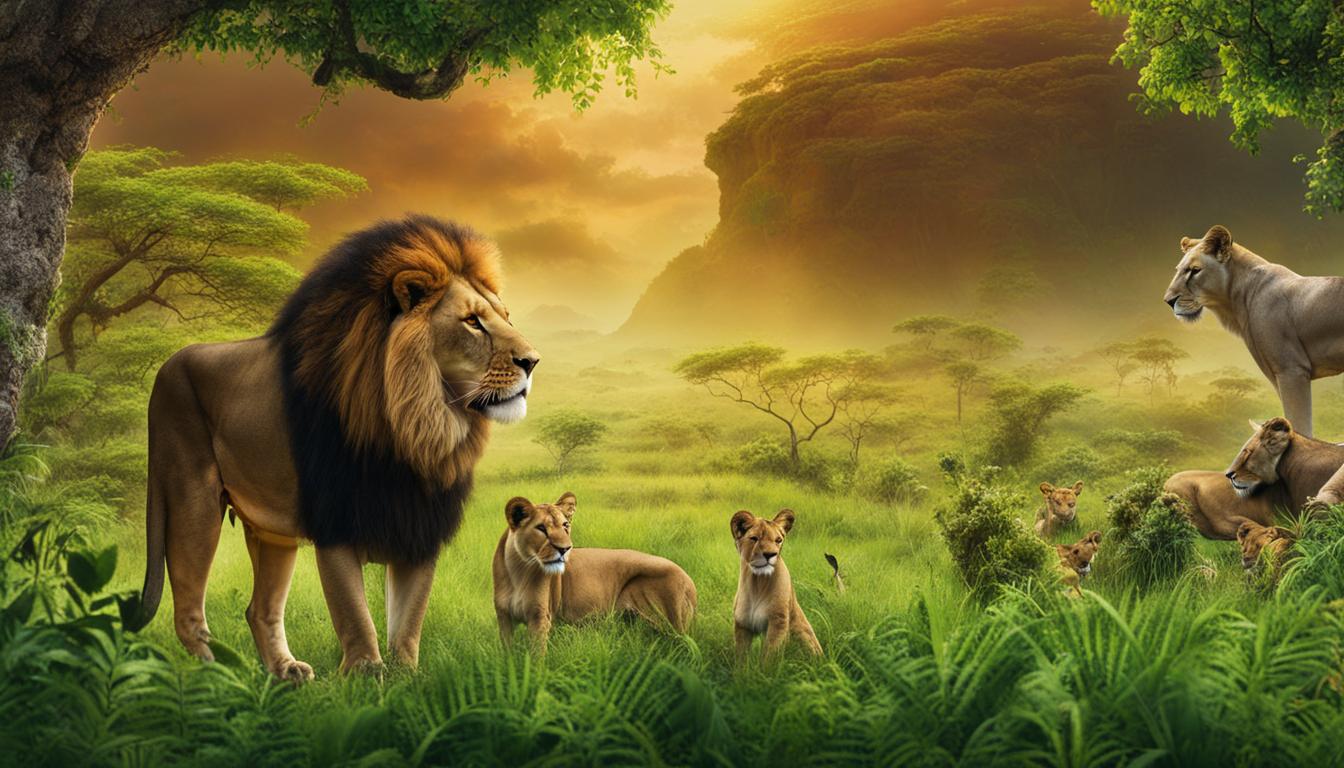Lions, one of the most iconic and majestic creatures on our planet, are facing significant threats to their population and habitats. Factors such as habitat loss, reduced prey availability, and conflict with humans have led to their decline in numbers. In order to ensure the survival of these magnificent big cats, various conservation efforts are being undertaken by organizations dedicated to wildlife protection and advocacy.
Lion conservation plays a crucial role in preserving not only this endangered species but also the delicate balance of ecosystems in which they reside. By focusing on habitat preservation, advocating for wildlife protection, and promoting coexistence between humans and lions, these efforts aim to safeguard the future of these incredible creatures.
Key Takeaways:
- Lion conservation is essential for protecting this endangered species and maintaining ecosystem balance.
- Efforts include habitat preservation, wildlife advocacy, and promoting coexistence between humans and lions.
- Conservation organizations play a vital role in monitoring lion populations and conducting anti-poaching operations.
- Challenges such as habitat loss and human-wildlife conflict pose significant threats to lion populations.
- Urgent action is needed to ensure the long-term survival and conservation of lions.
Born Free’s Pride of Amboseli Program: Addressing Human-Carnivore Conflict
Born Free’s Pride of Amboseli program, located in the Amboseli Ecosystem in Kenya, is dedicated to reducing human-carnivore conflict and promoting coexistence. This pioneering initiative tackles conflict head-on by constructing predator-proof bomas, which effectively prevent lions and other predators from accessing livestock.
The predator-proof bomas implemented by the Pride of Amboseli program are designed to not only protect livestock but also enhance sustainability and livelihoods within the community. These innovative structures incorporate smart elements such as water-storage units, solar lighting, and energy-saving stoves. By integrating these features, the program aims to improve the overall well-being of the local population while mitigating conflict.
The success of Born Free’s Pride of Amboseli program is evident in the reduction of retaliatory killings of lions and the gradual recovery of the lion population in the area. Through the implementation of predator-proof bomas and the emphasis on coexistence, the program has fostered a greater understanding and appreciation for the importance of lions and their role in the ecosystem, contributing to the conservation of this iconic species.
| Born Free’s Pride of Amboseli Program | Key Initiatives |
|---|---|
| Predator-proof bomas | Constructed to prevent lions and other predators from accessing livestock, reducing human-carnivore conflict |
| Sustainable livelihoods | Incorporating smart elements such as water-storage units, solar lighting, and energy-saving stoves to improve sustainability and livelihoods within the community |
| Reduction in retaliatory killings | The program’s efforts have resulted in a decline in retaliatory killings of lions |
| Lion population recovery | Contributing to the gradual recovery of the lion population in the Amboseli Ecosystem |
Through the Pride of Amboseli program, Born Free demonstrates the power of innovative solutions and community-driven conservation efforts in addressing human-carnivore conflict. By supporting sustainable livelihoods and promoting coexistence, the program paves the way for a brighter future where lions and local communities can thrive harmoniously.
Born Free’s Pride of Meru Program: Protecting Lion Strongholds
The Born Free’s Pride of Meru program is dedicated to protecting lion populations and their habitats in the Meru Conservation Area of Kenya. The program focuses on addressing human-carnivore conflict through various initiatives, including conflict mitigation strategies and lion population monitoring. By monitoring lion populations, the program can establish territories and distributions, gaining valuable insights into the behaviors and pride patterns of these majestic creatures.
In addition to population monitoring, the program implements conflict mitigation strategies to prevent livestock predation, reducing conflicts between communities and lions. By working closely with local communities, the program aims to improve attitudes towards lions and promote coexistence between humans and wildlife. Education on conservation plays a vital role in this program, raising awareness about the importance of protecting lion strongholds and emphasizing the need for sustainable practices.
Table: Summary of Born Free’s Pride of Meru Program
| Initiatives | Objectives |
|---|---|
| Lion population monitoring | Gaining insights into behaviors and pride patterns |
| Conflict mitigation strategies | Preventing livestock predation and reducing human-carnivore conflict |
| Conservation education | Raising awareness and promoting sustainable practices |
The Pride of Meru program is a vital part of Born Free’s efforts to protect lion strongholds and ensure the long-term survival of these iconic African animals. By implementing a comprehensive approach that combines population monitoring, conflict mitigation, and conservation education, the program strives to create a harmonious coexistence between lions and local communities. Through these collective efforts, Born Free and its partners are working to safeguard the future of lions and preserve their habitats for generations to come.
DSWF’s Lion Conservation Efforts in Uganda and Beyond
DSWF has been at the forefront of lion conservation since 1998, focusing on the protection and preservation of these magnificent creatures in Murchison Falls National Park, Uganda. Through their comprehensive initiatives, DSWF aims to address the alarming decline in lion populations and safeguard their habitats.
One of the key areas of DSWF’s lion conservation efforts is habitat restoration and protection. By working closely with local communities and conservation partners, DSWF undertakes projects to restore degraded lion habitats, ensuring the availability of suitable areas for their survival. This includes reforestation programs, establishment of protected areas, and sustainable land-use practices to promote a harmonious coexistence between lions and humans.
“We believe that effective anti-poaching efforts are crucial for ensuring the long-term survival of lions,” says Dr. Mark Jones, Head of Policy at DSWF. “Through our dedicated anti-poaching operations, we work tirelessly to remove snares, disrupt illegal wildlife trafficking networks, and provide training and support to local rangers.”
Research and Awareness
DSWF recognizes the importance of research in understanding lion behaviors, population dynamics, and the factors affecting their survival. Through collaboration with scientists and research institutions, DSWF conducts studies to gather valuable insights into the ecological needs of lions and develops evidence-based strategies for their conservation.
In addition to research, DSWF places great emphasis on raising awareness about lion conservation among local communities, stakeholders, and the broader public. By organizing educational programs, campaigns, and workshops, DSWF strives to foster a sense of stewardship and responsibility towards lions and their habitats, encouraging individuals to take action for their protection.
| DSWF’s Lion Conservation Efforts in Uganda and Beyond: | |
|---|---|
| Habitat Restoration and Protection | Working with local communities and conservation partners to restore degraded lion habitats, creating protected areas and promoting sustainable land-use practices. |
| Anti-poaching Operations | Removing snares, disrupting illegal wildlife trafficking networks, and providing training and support to local rangers. |
| Research | Collaborating with scientists and research institutions to gain insights into lion behaviors, population dynamics, and ecological needs. |
| Awareness | Raising awareness about lion conservation through educational programs, campaigns, and workshops to foster stewardship and responsibility. |
The Challenges Facing Lion Conservation
Lions, one of the most iconic and majestic creatures of the African savannas, are facing numerous challenges that threaten their population and survival. These challenges include habitat loss, human-wildlife conflict, poaching, and the illegal wildlife trade. Each of these factors contributes to the decline of lion populations and underscores the urgent need for conservation efforts to protect these magnificent animals and their habitats.
Habitat loss is a major issue affecting lion populations. As human activities such as agriculture, settlements, and road construction expand, lion habitats are shrinking, leaving them with limited space to roam and hunt. This not only disrupts their natural behavior and social structures but also increases the likelihood of conflicts with humans and other wildlife.
Human-wildlife conflict arises when lions come into contact with humans and their livestock. As lions lose their natural prey due to habitat loss, they may turn to livestock as an alternative food source. This can lead to retaliation by farmers, who often resort to killing lions to protect their livelihoods. It is essential to find ways to mitigate this conflict and promote coexistence between humans and lions to ensure the survival of both.
Poaching is another significant threat to lion populations. Lions are targeted for various reasons, including rituals, hunting trophies, and the illegal wildlife trade. Their bones, skins, and other body parts are highly valued in some cultures and markets. The demand for these items fuels the poaching of lions, further endangering their already vulnerable populations.
“The challenges facing lion conservation highlight the urgent need for concerted efforts to protect these magnificent creatures and their habitats. Through collaborative initiatives and awareness, we can work towards a future where lions continue to roam the African plains, ensuring the preservation of our natural heritage and biodiversity.” – Wildlife Conservation Advocate
Table: Major Threats to Lion Conservation
| Threat | Description |
|---|---|
| Habitat Loss | Human activities such as agriculture, settlements, and road construction result in the loss of lion habitats, limiting their range and hunting grounds. |
| Human-Wildlife Conflict | Lions coming into contact with humans and livestock leads to conflicts, with farmers resorting to killing lions to protect their livelihoods. |
| Poaching | Lions are targeted for rituals, hunting trophies, and the illegal wildlife trade, driving their populations even further towards extinction. |
The future of lions depends on our collective efforts to address these challenges and protect their populations. Conservation organizations, governments, local communities, and individuals must collaborate to implement measures that safeguard lion habitats, reduce human-wildlife conflict, combat poaching, and raise awareness about the importance of lion conservation. Together, we can make a difference in securing a brighter future for these magnificent big cats.
Lion Behaviors and Diet
Lions, known as the king of the jungle, exhibit fascinating behaviors and have a diverse diet. These majestic creatures are highly social and form prides consisting of multiple females, their offspring, and a dominant male. Within the pride, lions engage in activities like grooming, playing, and resting, reinforcing social bonds and establishing hierarchy. Their behaviors also include territorial marking through scent and roaring, both serving to communicate with other lions in the area.
When it comes to their diet, lions are apex predators and primarily feed on large herbivores. Their preferred prey species include zebras, wildebeests, and buffaloes, which they target due to their size and availability on the African savannas. With their incredible strength and coordination, lions use ambush tactics to bring down their prey, often relying on teamwork to increase hunting success rates. By hunting in coordinated groups, lions are able to surround and overpower much larger animals, ensuring a sustainable food source for their pride.
“Lion behaviors reflect their adaptability and social nature. From hunting strategies to territorial behaviors, these apex predators showcase their prowess and survival instincts in the African wilderness.”
Table: Lion Diet
| Prey Species | Percentage of Diet |
|---|---|
| Zebras | 40% |
| Wildebeests | 30% |
| Buffaloes | 20% |
| Antelopes | 10% |
Lion behaviors reflect their adaptability and social nature. From hunting strategies to territorial behaviors, these apex predators showcase their prowess and survival instincts in the African wilderness. Understanding these behaviors and their diet is crucial for conservation efforts aimed at protecting lion populations and ensuring their place in the ecosystem.
Lion Habitats and Conservation Importance
Lions are highly adaptable big cats that inhabit a range of ecosystems, including savannas, grasslands, and open woodlands. These diverse habitats provide lions with the necessary resources for survival, such as food, water, and shelter. However, the conservation of lion habitats goes beyond ensuring the existence of these majestic creatures. It also holds great significance for biodiversity and the overall balance of ecosystems.
The presence of lions in their natural habitats plays a crucial role in maintaining biodiversity. As top predators, lions help regulate prey populations, preventing overgrazing and ensuring the health of herbivore populations. This, in turn, has a cascading effect on the entire ecosystem, influencing the distribution and abundance of other animal species. By controlling prey populations, lions contribute to the balance and stability of ecosystems, promoting the coexistence of multiple species.
Furthermore, lion habitats are home to a variety of plant and animal species that are all interconnected in complex ecological networks. Conserving lion habitats means protecting the intricate web of life that relies on these ecosystems. Many species, from the smallest insects to the largest herbivores, depend on the presence of lions and other top predators to maintain the delicate balance of their respective ecosystems. By safeguarding lion habitats, we can ensure the preservation of these intricate ecological relationships and the overall functioning of natural systems.
The Importance of Lion Conservation
“Lions are not just iconic animals; they are keystone species that play a crucial role in shaping and maintaining the ecosystems they inhabit.” – Wildlife Conservation Society
The conservation of lions and their habitats is not just an endeavor to protect charismatic wildlife. It is an essential effort that contributes to the overall health and resilience of ecosystems. Lions, as keystone species, have a profound influence on the structure and function of their habitats. Their presence maintains the intricate balance of predator-prey dynamics, controls herbivore populations, and influences vegetation patterns. Without lions, these ecosystems would experience significant disruptions, leading to imbalances and potential ecological collapse.
| Conservation Significance of Lion Habitats | Lion Conservation Efforts |
|---|---|
|
|
Lion conservation efforts, led by organizations like Born Free and DSWF, play a critical role in safeguarding lion habitats and ensuring the long-term survival of these majestic creatures. Through habitat restoration, anti-poaching operations, research, and education, these organizations address the challenges facing lion populations and work towards maintaining the ecological balance of their habitats. By supporting these conservation initiatives, individuals can actively contribute to the protection of lion habitats and the preservation of the intricate web of life that depends on them.
Conclusion
In conclusion, lion conservation efforts are of utmost importance to protect these majestic creatures and their habitats. The alarming decline in lion populations due to habitat loss, human-wildlife conflict, poaching, and the illegal wildlife trade necessitates urgent action.
Organizations like Born Free and DSWF are actively working towards lion conservation through various initiatives. These include promoting coexistence between humans and lions, implementing conflict mitigation strategies, conducting research on lion behaviors, and supporting anti-poaching operations. By supporting these organizations and their initiatives, you can play a crucial role in ensuring the long-term survival and conservation of lions.
Your support is vital in preserving the biodiversity and balance of ecosystems that lions contribute to. Together, we can make a difference and protect these iconic African animals for future generations.
What Are the Main Threats to Lions and How Can We Protect Them?
The decline of lions in the wild necessitates robust conservation efforts for protecting lions. Habitat loss due to human activities, poaching for illegal wildlife trade, and conflict with communities are among the main threats faced by these magnificent creatures. Safeguarding their habitats, implementing anti-poaching measures, promoting education and awareness, and engaging local communities in conservation initiatives are crucial steps towards ensuring a future for lions in the wild.
Are the Issues Faced by Tigers in Captivity Similar to Those Faced by Lions in the Wild?
The issues tigers face in captivity differ from those faced by lions in the wild. Tigers in captivity often struggle with limited space, lack of mental stimulation, and health problems. Conversely, lions in the wild face challenges such as territorial disputes, limited prey availability, and threats from human activities. These distinct environments present unique hardships for each species.
FAQ
What are the key conservation efforts to protect lions?
The key conservation efforts to protect lions include reducing human-carnivore conflict, promoting coexistence, constructing predator-proof bomas, monitoring lion populations, and conducting anti-poaching operations.
How does Born Free’s Pride of Amboseli Program address human-carnivore conflict?
Born Free’s Pride of Amboseli Program addresses human-carnivore conflict by constructing predator-proof bomas, which prevent lions and other predators from accessing livestock. These bomas also incorporate smart elements to improve sustainability and livelihoods.
What is the focus of Born Free’s Pride of Meru Program?
Born Free’s Pride of Meru Program focuses on reducing human-carnivore conflict and promoting coexistence. The program conducts monitoring of the lion population, implements conflict mitigation strategies, and works on conservation education initiatives.
What are DSWF’s lion conservation efforts in Uganda and beyond?
DSWF is actively involved in lion conservation in Uganda, primarily focused on Murchison Falls National Park. Their efforts include habitat restoration and protection, research on lion behaviors, anti-poaching operations, and supporting ground-based conservation partners in Zambia and Zimbabwe.
What are the challenges facing lion conservation?
The challenges facing lion conservation include habitat loss, human-wildlife conflict, poaching, and the illegal wildlife trade.
What are some lion behaviors and their diet?
Lions exhibit behaviors such as socializing in prides, territorial marking, and hunting in coordinated groups. Their diet mainly consists of large herbivores such as zebras, wildebeests, and buffaloes, although they also prey on smaller animals like antelopes.
Why are lion habitats and conservation important?
Lion habitats are crucial for maintaining biodiversity and the balance of ecosystems. Lions help regulate prey populations and prevent overgrazing, ensuring the health and sustainability of the entire ecosystem.
What is the importance of lion conservation efforts?
Lion conservation efforts are essential to protect these majestic creatures and their habitats from decline. Urgent action is needed to ensure their long-term survival and contribute to the conservation of this iconic African animal.










